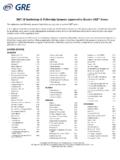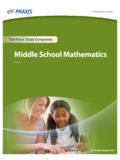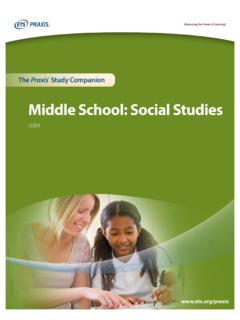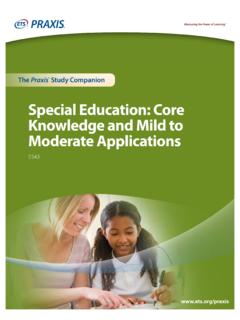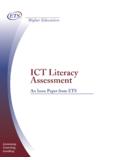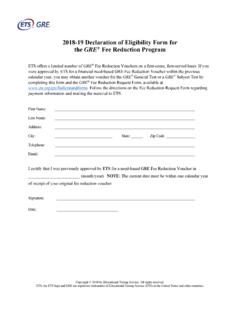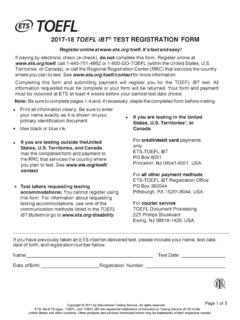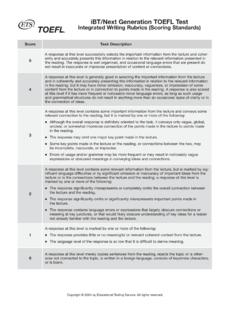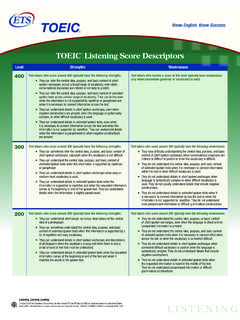Transcription of School Leaders Licensure Assessment Study Companion
1 School Leaders Licensure Assessment SLS Study CompanionThe SLS Study Companion2 Welcome to the SLS Study CompanionWelcome to The SLS Study Companion Prepare to Show What You KnowYou have been working to acquire the knowledge and skills you need for your teaching career. Now you are ready to demonstrate your abilities by taking an S L S test. Using the S L S Study Companion is a smart way to prepare for the test so you can do your best on test day. This guide can help keep you on track and make the most efficient use of your Study Study Companion contains practical information and helpful tools, including: An overview of the S L S tests Specific information on the S L S test you are taking A template Study plan Study topics Practice questions and explanations of correct answers Test-taking tips and strategies Frequently asked questions Links to more detailed informationSo where should you start?
2 Begin by reviewing this guide in its entirety and note those sections that you need to revisit. Then you can create your own personalized Study plan and schedule based on your individual needs and how much time you have before test in mind that Study habits are individual. There are many different ways to successfully prepare for your test. Some people Study better on their own, while others prefer a group dynamic. You may have more energy early in the day, but another test taker may concentrate better in the evening. So use this guide to develop the approach that works best for teaching career begins with preparation. Good luck!Know What to ExpectWhich tests should I take? Each state or agency that uses the S L S tests sets its own requirements for which test or tests you must take for the teaching area you wish to you register for a test, confirm your state or agency s testing requirements at are the S L S tests given?
3 S L S tests are given on computer. Other formats are available for test takers approved for accommodations (see page 57).The SLS Study Companion3 Welcome to the SLS Study CompanionWhat should I expect when taking the test on computer?When taking the test on computer, you can expect to be asked to provide proper identification at the test center. Once admitted, you will be given the opportunity to learn how the computer interface works (how to answer questions, how to skip questions, how to go back to questions you skipped, etc.) before the testing time begins. Watch the What to Expect on Test Day video to see what the experience is and when are the SLS tests offered?You can select the test center that is most convenient for you. The S L S tests are administered through an international network of test centers, which includes Prometric Testing Centers, some universities, and other locations throughout the schedules may differ, so see the S L S Web site for more detailed test registration information at The SLS Study Companion4 Table of ContentsTable of ContentsThe S L S Study Companion guides you through the steps to success1.
4 Learn About Your Test ..5 Learn about the specific test you will be taking2. Familiarize Yourself with Test Questions ..14 Become comfortable with the types of questions you ll find on the SLS tests3. Practice with Sample Test Questions ..18 Answer practice questions and find explanations for correct answers4. Determine Your Strategy for Success ..35 Set clear goals and deadlines so your test preparation is focused and efficient5. Develop Your Study Plan ..38 Develop a personalized Study plan and schedule6. Review Study Topics ..42 Review Study topics with questions for discussion7. Review Smart Tips for Success ..55 Follow test-taking tips developed by experts8. Check on Testing Accommodations ..57 See if you qualify for accommodations to take the S L S test9. Do Your Best on Test Day.
5 58 Get ready for test day so you will be calm and confident10. Understand Your Scores ..60 Understand how tests are scored and how to interpret your test scoresAppendix: Other Questions You May Have ..62 The SLS Study Companion5 Step 1: Learn About Your Test1. Learn About Your TestLearn about the specific test you will be takingSchool Leaders Licensure Assessment (6990)Test at a GlanceTest Name School Leaders Licensure AssessmentTest Code 6990 Time 4 hours, divided into two separately timed sections: a 165-minute selected-response section and a 75-minute constructed-response sectionNumber of Questions Section I: 120 selected-response questions (165 minutes) Section II: 4 constructed-response questions (75 minutes), calling for written answers based on scenarios and sets of documents that an education leader might encounterFormat Selected-response and constructed-response questionsTest Delivery Computer delivered Approximate Approximate Content Categories Number of Percentage of Questions Examination I.
6 Strategic Leadership 20 13% II. Instructional Leadership 27 17% III. Climate and Cultural Leadership 22 13% IV. Ethical Leadership 19 12% V. Organizational Leadership 16 10% VI. Community Engagement Leadership 16 10% VII. Analysis Constructed Response (CR) 4 25%VIIVIVIVIIIIIIA bout This TestThe School Leader Licensure Assessment (SLLA) is designed to measure the extent to which entry-level School Leaders demonstrate the standards-relevant knowledge and skills necessary for competent professional content of the SLLA was defined by a national committee of expert practitioners and preparation faculty and confirmed by a national survey of the School Leader Licensure Assessment is aligned with the 2015 Professional Standards for Educational Leaders (PSEL), developed by the National Policy Board for Educational Administration (NPBEA).
7 These standards were previously known as the Interstate School Leaders Licensure Consortium (ISLLC) four-hour testing time is divided into two separately timed sections. During this time, the test taker will respond to the 120 selected-response questions and 4 constructed-response test may contain some questions that do not count toward your SLS Study Companion6 Step 1: Learn About Your TestI. Strategic LeadershipA. Mission, vision, goals, and core valuesA School leader1. Understands how to develop an educational mission for the School to promote the academic success and well-being of each student2. Understands how to analyze multiple sources of data about current practice before developing or revising the mission, vision, and goalsa. selects appropriate School goals that are aligned with district goals and based on datab.
8 Evaluates if the current mission, vision, and goals are appropriate3. Understands how to implement a vision and goals that reflect core values and are created with challenging and measureable expectations for all students and educatorsa. determines if expectations are measurable, rigorous, and connected to the vision and goalsb. develops goals that are specific, measurable, attainable, results driven, and time boundc. identifies resources for developing the mission, vision, and goals4. Knows how the vision and goals relate to local, state, and federal policies5. Understands how to model the School s mission, vision, and core values in all aspects of leadershipB. Shared commitments to implement the vision and goalsA School leader1. Understands how to engage staff and community members with diverse perspectives in implementing the vision and achieving goalsa.
9 Identifies strategies to engage internal and external communities with diverse perspectives to implement the vision and goals2. Knows how to develop shared commitments and responsibilities among staff and the community for selecting and carrying out effective strategies to achieve the vision and goalsa. builds consensusb. develops a plan to delegate responsibilities3. Knows how to determine and implement effective strategies to evaluate progress toward the vision and goals4. Knows how to communicate the shared vision and goals in ways that facilitate key faculty, staff, students, parents, and community members ability to understand, support, and act on thema. Selects and assesses communication strategies for faculty, staff, students, parents, and community membersC. Continuous improvement toward the vision and goals1.
10 Understands how to use and interpret multiple sources of data to conduct a needs analysis to identify unique strengths, needs, gaps, and areas of improvement for students and teachers2. Knows how to use data-driven decision making, research, and best practices systematically to design and monitor plans, programs, and activities to achieve the vision and goalsTest SpecificationsTest specifications in this chapter describe the knowledge and skills measured by the test. Study topics to help you prepare to answer test questions can be found on page SLS Study Companion7 Step 1: Learn About Your Test3. Knows effective strategies to facilitate needed changea. manages uncertainty and riskb. supports the needs of individuals during the change processc. communicates the needs, process, and outcomes of improvement effortsd.
